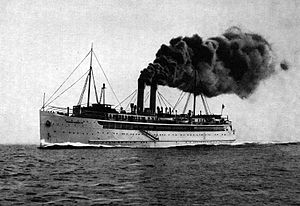Konung Gustav V
| Konung Gustav V | |
|---|---|
 The Konung Gustav V in 1910 |
|
| Ship data | |
| Flag: |
|
| IMO number: | |
| Shipping company : | Statens Järnvägar |
| Commissioning: | March 14, 1910 |
| Decommissioning: | 1968 |
| Builder: | Lindholmens Verkstad , Gothenburg , construction number 402 |
| Whereabouts: | scrapped |
| Technical specifications | |
| Measurement : | 3,268 GRT / 1,414 NRT |
| Length (Lüa) : | 113.47 m |
| Width: | 16.24 m |
| Draft : | 5.18 m |
| Ship propulsion : | Two 3-cylinder steam engines from Motala Verkstad with a total of 5,800 hp from 1953 oil-fired |
| Cruising speed : | 16 kn |
| Usable track length: | 2 tracks, a total of 165 m |
| Capacity: | 18 passenger carriages 975 passengers |
The Konung Gustav V was a Swedish rail ferry that operated on the Baltic Sea from 1910 to 1968 .
Construction and technical data
The ship was in June 1909 with the yard number 402 at the shipyard Lindholmens Verkstad in Gothenburg for the Swedish state railway Statens Järnvägar from the stack . It was almost identical in construction to the Drottning Victoria , launched in February 1909 at the Swan, Hunter & Wigham Richardson shipyard in Newcastle upon Tyne , England . The Konung Gustav V was 113.47 m long and 16.24 m wide and had a draft of 5.18 m . She was measured with 3268 GRT and displaced 2402 tons . Two 3-cylinder steam engines from Motala with 5800 hp gave it a top speed of 16 knots . The ship could accommodate up to 18 passenger coaches on two tracks with a total length of 165 m and had space for up to 975 passengers . In the spring of 1953, the furnace was switched from coal to oil.
career
The ship was delivered to Statens Järnvägar on March 9, 1910, and began service on March 14, 1910 on the so-called " King's Line " opened on July 6, 1909 between Trelleborg (Sweden) and Sassnitz ( Rügen ). Although Sweden ordered its ships back to Sweden for safety reasons on August 1, 1914 when the First World War broke out, the Konung Gustav V resumed its liner service on August 21, 1914 (the German ferry Prussia also ran again from October 30, 1914 on the "royal line"). It was not until the Second World War that civil passenger traffic on the “King's Line” was stopped on February 27, 1942 and all ferry traffic on September 26, 1944. Previously, on February 26, 1942, the Swedish ferry Starke ran into a drifting mine off Rügen and sank to a depth of 25 m, and on October 19, 1942, the Soviet submarine D 2 had badly damaged the German ferry Germany with a torpedo and the cone Gustav V missed with a second torpedo.
After the end of the war, the Konung Gustav V, like her sister ship Drottning Victoria and from 1946 also the Starke , which was added in 1931 , provided ferry service from Trelleborg to Gdańsk from November 1945 and from April 25, 1946 to Gdynia . More than 1,300 railway wagons were transported to Poland, which Sweden made available as a contribution to post-war reconstruction. The ferry service to Poland was relocated to Odra Port, Świnoujście (Swinoujscie) in February 1948 . Only on June 11, 1947, the Swedish ships on the Trelleborg – Warnemünde route began operating again with Germany. After on 10./11. Successful negotiations between the Swedish State Railways, the Deutsche Reichsbahn and the Soviet Military Administration about the resumption of ferry traffic to Sassnitz had taken place on the Konung Gustav V on March 16, 1948, the ship resumed ferry traffic from Trelleborg to Sassnitz on March 16, 1948 and ran that day for the first time back in Sassnitz. From October 4, 1952 to August 17, 1953, the ferry traffic to Sassnitz was stopped again by order of the Soviet military administration and instead diverted to Warnemünde. In the summer of 1953 the Konung Gustav V , which had been provided with an oil furnace in the spring, also served between Trelleborg and Travemünde.
The old double-track ferries were gradually no longer able to cope with the growing transit traffic on the Sassnitz – Trelleborg ferry line because of their limited capacity and technical performance, so that new buildings were necessary. After a jointly operated ferry service had been set up again on the basis of a government agreement between Sweden and the GDR in order to appropriately share the financial burdens between the Swedish State Railways and the Deutsche Reichsbahn , this was possible. In April 1958, the Drottning Victoria was replaced by the new Swedish four-track ferry Trelleborg , which also had a separate car deck. When the new Sassnitz Reichsbahn ferry was ready for use in July 1959, the Gustav V cone was also removed from regular service. The two elderly ships were in reserve ferries in Trelleborg launched and served only as needed (either as a substitute for dry docking of the new ships, or as reinforcement in the summer season) on their traditional route or on the route Malmö-Copenhagen. Otherwise, they were used in the summer months for excursion services between Travemünde and Trelleborg, which opened in 1953.
In 1968 the Konung Gustav V was sold for demolition and scrapped in Ystad .
Web links
- http://www.ffektaomfartyg.se/konung_gustav_V_1910.htm
- Wulf Krentzien: The Sassnitz-Trelleborg line in old views
- The auto age begins, p. 74 (PDF; 5.8 MB)
- Konung Gustav V , on the Swedish Railways website, with postcard views
- http://www.trelleborg.se/lar-kanna-trelleborg/Historiskt/Trelleborgsfartyg/Kungen--kom-ett-ar-efter-sin-drottning/
Individual evidence
- ↑ The ship was lifted in the same year and then repaired in Malmö until 1946.
